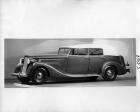|
cuno auto-klean oil filter
|
||||
|---|---|---|---|---|
|
Home away from home
|
Hello all,
I came across a NOS Cuno Auto-Klean permanent oil filter that had "Packard '30-'37" marked on the box. Apparently, these type of "metal cleanable edge" filters are still being manufactured for industrial use. Although I've read the sheet on these, I don't really understand how they work. Can anyone explain? Here is the link:http://multimedia.3m.com/mws/media/499342O/cunotm-ef-eg-egs-self-cleaning-metal-filters.pdf?&fn=CUNO%20EG_EGS.pdf
Posted on: 2017/6/12 22:02
|
|||
|
Rob
1930 Custom 8 Club Sedan |
||||
|
||||
|
Re: cuno auto-klean oil filter
|
||||
|---|---|---|---|---|
|
Home away from home
|
Now I understand. Thank you HH56! I'm thinking of using it on my '30 Packard, while of course changing the oil at frequent intervals as well. Sounds like it would work as well as a Purolator of the time.
Posted on: 2017/6/13 14:52
|
|||
|
Rob
1930 Custom 8 Club Sedan |
||||
|
||||
|
Re: cuno auto-klean oil filter
|
||||
|---|---|---|---|---|
|
Home away from home
|
I remember reading a old motors manual late thirties or forties about this type of filter. My dad had one which he installed on one of his cars. Told me the Navy used them on bearing system during the WW2. I remember him taking it apart to clean out the dirt and stuff that settled in the bottom.
Posted on: 2017/6/13 19:08
|
|||
|
C:\Users\veron\Desktop\New folder\1956 Packard Caribbean\753.jpg
|
||||
|
||||








